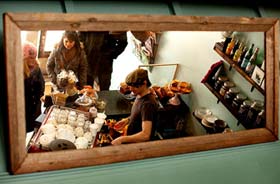New York Coffee, return to "elaborate work"

In the spare afternoon, it is definitely a pleasure to sit in the open-air coffee bar on New York's Fifth Avenue, listen to a piece of light music and taste a cup of frothy cappuccino made by the barista himself. Not long ago, however, it was an extravagant hope, when New Yorkers didn't think it was a great thing to make coffee. Compared with New York's economy, it is only a second-tier city in the coffee industry, and they are much more interested in instant coffee.
However, the situation is beginning to change. In the past two years, more than 40 cafes or coffee bars have joined a group specializing in the art of coffee. With their promotion and efforts, more and more people are making coffee as an art and paying attention to enjoying high-quality coffee.
The second-tier city of coffee is promoted to the first tier.
Guests who have tasted the espresso at the Bluebird Coffee Store in the East Village of New York City will be impressed by the strong and smooth taste of the coffee. There is also the East Village Abraco's Dilu coffee, smell, taste, but also add to see, looking at the drop of coffee liquid from the container, is also a kind of busy life time to enjoy. In the elaborate cappuccino at the three Railway Cafe in the West Village of New York City, baristas cover coffee cups with lovely foam through very tedious processes such as steaming milk, which is also mouth-watering. A few years ago, New Yorkers had to drive to the Stamper City Coffee Roasters in Portland or the Blue bottle Cafe in San Francisco to taste such unique and high-quality coffee, because in fast-paced New York, instant coffee looks more popular.
But now they can taste fresh coffee from all over the world without leaving home, because not only are more and more companies in New York City pouring money into the coffee industry, the famous coffee city San Francisco is also opening branches and new stores in New York, and more importantly, these stores are paying more attention to the quality of coffee, such as Caf é Grumpy and Abraco. Unlike the instant coffee in the past, they basically grind and boil coffee beans to make fresh coffee, and they also regard this process as an art and enjoyment, which is very different from the instant coffee before. So New York City is moving from a second-tier coffee city to a first-tier city.
Grind and brew fine coffee by hand
Perhaps mechanized production is too rampant in recent years, or unhand-ground coffee destroys the original flavor. at present, handmade coffee is considered to be of high quality. However, while many cafes are switching to handmade coffee, there will still be many coffee chains using automatic coffee machines. Some baristas who focus on high-quality coffee believe that these automatic coffee mechanisms set a fixed time and temperature before making coffee, and use almost the same weight of coffee powder, so the taste is the same. For example, some coffee chains use 7 grams of powder when making coffee, including 5 grams of coffee powder and 2 grams of partner, while the coffee produced is also 56 grams.
However, the really good coffee is controlled by the baristas themselves. For example, baristas at Clover Cafe in New York City mix 19 to 21 grams of ground coffee powder with 42 to 56 grams of liquid, and the specific amount varies from person to person, and their espresso has its own characteristics.
In addition to making by hand, cafes in New York City have also put a lot of effort into making tools. In order to enhance the quality of hand-brewed coffee, many cafes are equipped with multiple coffee bean grinders, each of which is specially used to grind a flavor of coffee beans. For example, one is used to grind Italian espresso, one is used to make decaffeinated espresso, and one is used to make fresh brewed coffee. When these cafes need two or more kinds of coffee beans to mix the flavor, they also prepare a separate grinder to grind the coffee powder, in their words: "this is to ensure the purity of the coffee taste."
Of course, there are some cafes that do not agree with this kind of "meticulous craftsmanship". They have their own understanding of high quality, but whether they can really be loved by consumers is another matter. The Ninth Avenue Cafe, for example, is one of them. They think that drinking coffee should be done quickly from a ceramic coffee cup whose temperature is not too high. If you want an artistic cappuccino here, they will say, "We don't make this kind of coffee." They think that the coffee they grind is evenly tamped, the water used to boil the beans is at the right temperature and at the right time, but consumers seem to have a different opinion of them. Louis is a consumer who is demanding about coffee: "I don't think their coffee tastes good, on the contrary, it tastes bad!"
There are also new business opportunities in cafes.
The transformation of New York into a first-tier city of coffee is not only reflected in that coffee production pays more attention to quality and taste, but more importantly, coffee also brings new business opportunities to this international city. In a new children's activity center in Tribel, parents often sit in the lounge area to taste cappuccinos made there when they are tired of accompanying their children. In addition, Saturday Surfing, a small family surfing shop, also has a fine coffee service, and the coffee-making machine is next to the cash register. The shopkeeper said, "High-quality coffee has gradually formed an unwritten rule in New York." Now, in addition to cafes, some companies that do not focus on coffee are also able to produce high-quality coffee in accordance with this regulation. This is a new business opportunity for coffee development in New York. " Grolan, a consumer who often goes there for leisure, also said: "watching the production of coffee when you are tired is sometimes a kind of fun, which is very attractive."
In addition, there is another scene in New York City. As spring approaches, more and more cafes have begun to set up seats outside the shops. When these seats are full of streets, there are different outdoor coffee bar streets in New York City. What is even more amazing is that people only taste the finished coffee outside, but now more of the process of making coffee has moved to the outdoors. So these outdoor boutique coffee bars not only seize the business opportunities, but also bring beauty to New York City.
Important Notice :
前街咖啡 FrontStreet Coffee has moved to new addredd:
FrontStreet Coffee Address: 315,Donghua East Road,GuangZhou
Tel:020 38364473
- Prev

The proud coffee culture of the Viennese
Coffee is something that Viennese enjoy talking about and are quite proud of. The Viennese even compare it with music and waltz, which is called the three treasures of Vienna, which shows the relationship between Viennese and coffee. Some people say that Vienna is a five-step coffee, which may be an exaggeration by the poet, but it is true that there are a large number of Vienna cafes. Coffee kiosks for people to drink standing up from street corners,
- Next

The Spread of Coffee/ Coffee spread
The spread of coffee to Asia The Arabians could not spread coffee in Asia but the Dutch did! In the process of Dutch colonization, they grew coffee in Maraba, Indiaand brought coffee to Batavia in Java, Indonesia in 1699. The Dutch colonie
Related
- Beginners will see the "Coffee pull flower" guide!
- What is the difference between ice blog purified milk and ordinary milk coffee?
- Why is the Philippines the largest producer of crops in Liberia?
- For coffee extraction, should the fine powder be retained?
- How does extracted espresso fill pressed powder? How much strength does it take to press the powder?
- How to make jasmine cold extract coffee? Is the jasmine + latte good?
- Will this little toy really make the coffee taste better? How does Lily Drip affect coffee extraction?
- Will the action of slapping the filter cup also affect coffee extraction?
- What's the difference between powder-to-water ratio and powder-to-liquid ratio?
- What is the Ethiopian local species? What does it have to do with Heirloom native species?

